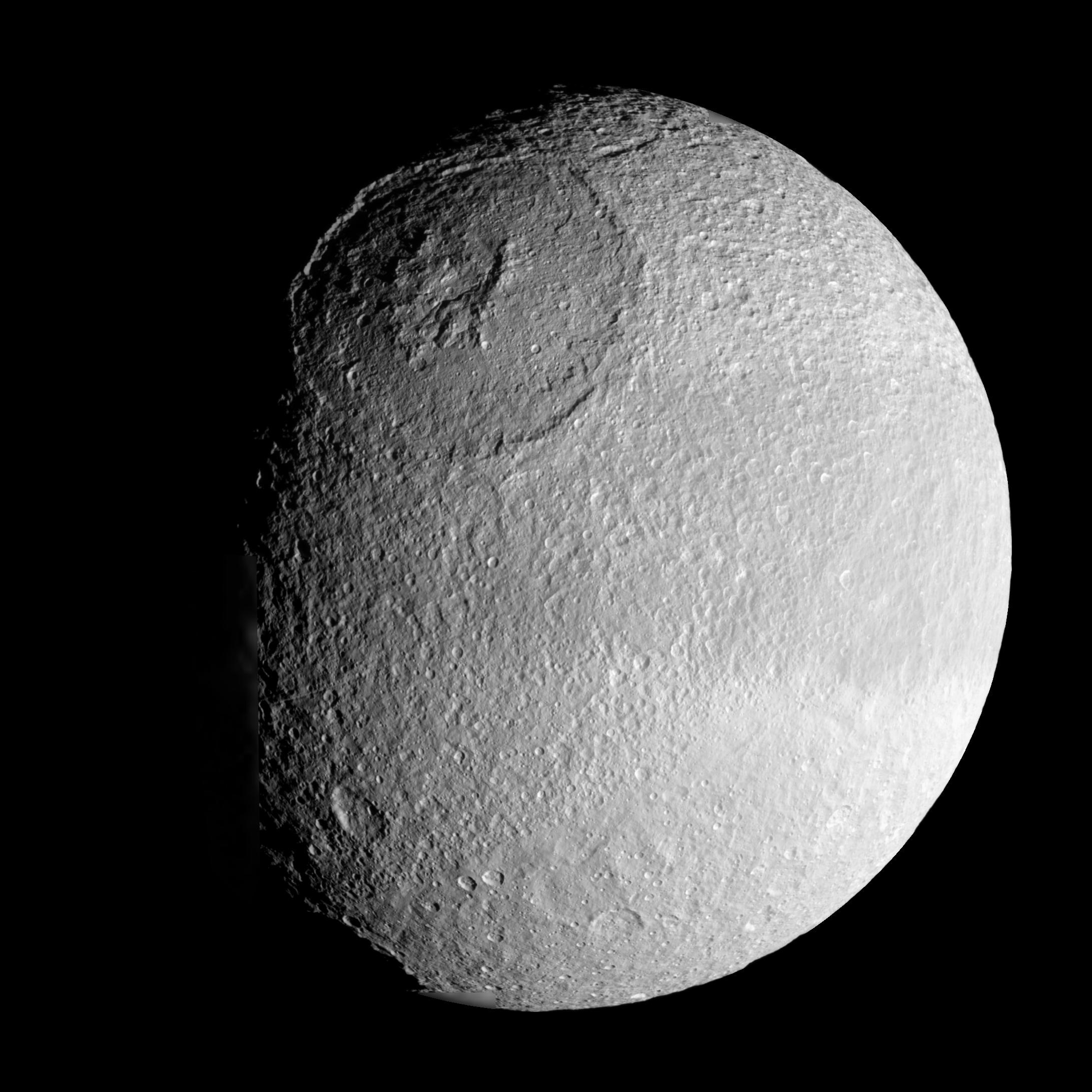Tethys

Giovanni Cassini discovered Tethys on March 21, 1684.
Tethys is Saturn's fifth largest moon. Its irregular shape is 331 miles (533 kilometers) in mean radius, with dimensions 669 x 657 x 654 miles (1076.8 x 1057.4 x 1052.6 kilometers). This cold, airless and heavily scarred body is very similar to sister moons Dione and Rhea except that Tethys is not as heavily cratered as the other two. This may be because its proximity to Saturn causes more tidal warming, and that warming kept Tethys partially molten longer, erasing or dulling more of the early terrain.
Tethys' density is 0.97 times that of liquid water, which suggests that Tethys is composed almost entirely of water ice plus a small amount of rock.
Tethys has a high reflectivity (or visual albedo) of 1.229 in the visual range, again suggesting a composition largely of water ice, which would behave like rock in the Tethyan average temperature of -305 degrees Fahrenheit (-187 degrees Celsius). Many of the crater floors on Tethys are bright, which also suggests an abundance of water ice. Also contributing to the high reflectivity is that Tethys is bombarded by Saturn E-ring water-ice particles generated by geysers on Enceladus.
Tethys appeared as a tiny dot to astronomers until the Voyager (1 and 2) encounters in 1980 and 1981. The Voyager images showed a major impact crater and a great chasm. The Cassini spacecraft has added details including a great variety of colors at small scales suggesting a variety of materials not seen elsewhere.
Tethys orbits 183,000 miles (295,000 kilometers) from Saturn, taking 45.3 hours to circle the planet. As with all but two of the major Saturnian moons, Tethys is tidally locked in phase with its parent planet — the same side always faces toward Saturn.
Tethys has gravitationally locked two smaller moons into its own subsystem — Telesto and Calypso. These smaller moons are held in Lagrangian points (L4 and L5, respectively), where objects are stable with the larger controlling body. These three moons complete their orbits around Saturn moving as a unit, spaced out at 60-degree intervals first Telesto, then Tethys, followed by Calypso. The fact that Tethys and other Saturnian moons have such objects implies that their respective Lagrangian points have been stable against outside influences for millions of years.
The Tethyan northern hemisphere is lighter colored and heavily reworked from ages of bombardment. For instance, near the prominent peaked crater Telemachus (Odysseus' son in "The Odyssey") are the remnants of Teiresias Crater (named for a famous soothsayer of ancient Greece). The ancient Teiresias impact site is so badly overprinted and eroded by impact weathering and degradation that only a circular pattern of hummocks remains to indicate the old crater rim.
Closer to the equator, the terrain is darker and has fewer craters. This less-dense cratering suggests past internal activity and resurfacing of the terrain.
Around the equator on its leading side, Tethys wears a band of slightly darker surface material. Scientists suspect the darkened region may represent an area of less contaminated ice with differently sized grains than the material at higher latitudes on either side of the band.
Tethys has two overpowering features, a giant impact crater and a great valley. Odysseus Crater (named for a Greek warrior king in Homer's two great works, "The Iliad" and "The Odyssey") dominates the Tethyan western hemisphere. Odysseus Crater is 250 miles (400 kilometers) in diameter. That diameter is nearly two-fifths of Tethys itself. Such an impact could have shattered a solid body, which suggests that the internal composition of Tethys was still partially molten. The crater's rim and central peak have largely collapsed, leaving a shallow crater, and this also suggests a terrain that was elastic enough to change shape. The subdued features of Odysseus Crater are in contrast to the many steep cliffs found elsewhere on the moon, which again suggests that the ancient terrain was still elastic enough to change shape.
The second major feature, a valley called Ithaca Chasma (named for the country ruled by Odysseus), runs roughly from the Tethyan north pole to its south pole. It is 62 miles wide, 2 to 3 miles deep, and extends 1,200 miles (100 kilometers, 3 to 5 kilometers, and 2,000 kilometers, respectively). Ithaca Chasma may have been caused by expansion of internal liquid water as it froze into ice after the surface had already frozen. An alternate theory is that the impact that created the Odysseus Crater also generated forces that created Ithaca Chasma, especially since the chasm is on the opposite side of Tethys from the Odysseus Crater. The chasm and surrounding area are heavily cratered, indicating that it was formed long ago.
Cassini referred to Tethys as one of the four Sidera Lodoicea (Stars of Louis) after King Louis XIV (the other three were Iapetus, Dione and Rhea). Other astronomers called the Saturn moons by number in terms of their distance from Saturn. Thus, Tethys was Saturn III. John Herschel suggested that the moons of Saturn be associated with the Greek mythical brothers and sisters of Kronus. (Kronus is the equivalent of the Roman god Saturn in Greek mythology.)
The name comes from the Greek goddess (or Titan) Tethys, who was the daughter of Uranus and Gaea, a sister to Kronus and the wife of Oceanus. She was said to be the mother of the chief rivers, the mother of three thousand daughters called the Oceanids and the embodiment of the waters of the world.
Geological features on Tethys generally get their names from "The Odyssey" by Homer. The International Astronomical Union now controls naming of astronomical bodies.




